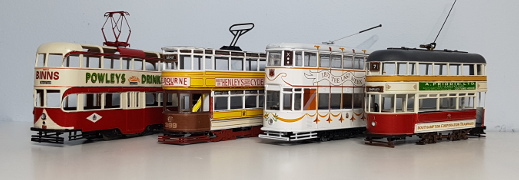

How to apply Tramads Transfers
Tramads Waterslide Transfers are easy to apply, but please read these notes first, especially if you are not an experienced modeller.
The transfers must be accurately cut to size before use. Where the transfer contains light colours it will be printed on a white backing sheet, and accurately cutting so that no white remains is needed. In some cases blending the white edge in with matching paint will enhance the finished result. When applying these to diecast models with ads already on it is recommended to either remove the original ad first, and/or preferably mask and spray the area with a light coat of white to prevent any colour bleeding through. This also helps when applying light transfers directly to dark paint.
The surface to which you intend to apply the transfer should be smooth, clean and free from dust or any residue, and if painted should be gloss. Matt finishes are not suitable for applying waterslide transfers as they can result in poor adhesion, and an effect known as silvering. If matt or satin finish is required on the model, then it should be sprayed or painted with a matt/sating varnish after applying the transfers to a gloss finish. Alternatively Johnson's Klear can be used over matt paint - search the internet for the best methods of using this.
Once cut, drop the transfer into a small container with about a quarter inch depth of warm (but not hot) water. The transfer will curl as the backing paper expands, and may float or may sink, it does not matter which. After 30 seconds or so, as the transfer glue begins to release from the backing, the transfer will straighten out again. At this point it should be taken out of the water, and very carefully holding it between thumb and forefinger test that the transfer will slide along the paper for it's whole length. If not dip it back into the water for a few more seconds. Take care not to stretch the transfer when checking if it has released from the backing paper.
It often helps to slightly moisten the panel on the model using a wet finger. Hold the transfer in roughly the desired position and slide the backing papaer out from under the transfer, leaving it on the model. You now have a couple of minutes to accurately position the transfer - slide it into the correct position using you finger, or for smaller transfers us a wet paint brush. If you have too much water the transfer will float around, so use kitchen paper to blot some of it away. If it is too dry it may not slide, so use a wet paint brush to add more water.
Once you are happy with the position, then remove any excess water with a piece of kitchen paper, being careful not to move it whilst doing so. The transfer should then be left untouched to dry for 24 hours. The transfer should then be protected with a coat of lacquer if it will be subject to frequent handing.
Several products are available to assist in applying or setting transfers. When applying transfers over detail such as beading, we recommend MicroSet from Microscale, brushing it onto the model before applying the transfer. Other products are available, but have not all been tested with tramads, however Solvaset by Walthers has been reported to cause problems. Please read the manufacturers instructions for using these and test on a scrap piece first. (Please request a free test piece when ordering if required).
For full dash transfers the easiest way to cut out the hole for the headlight is to use a single hole punch - first select the correct size of hole, then hold the transfer over a piece of card before carefully aligning and then punching.
For more information, inspiration, and to meet other tram modellers willing to share their experience with you go to Model Tramways.